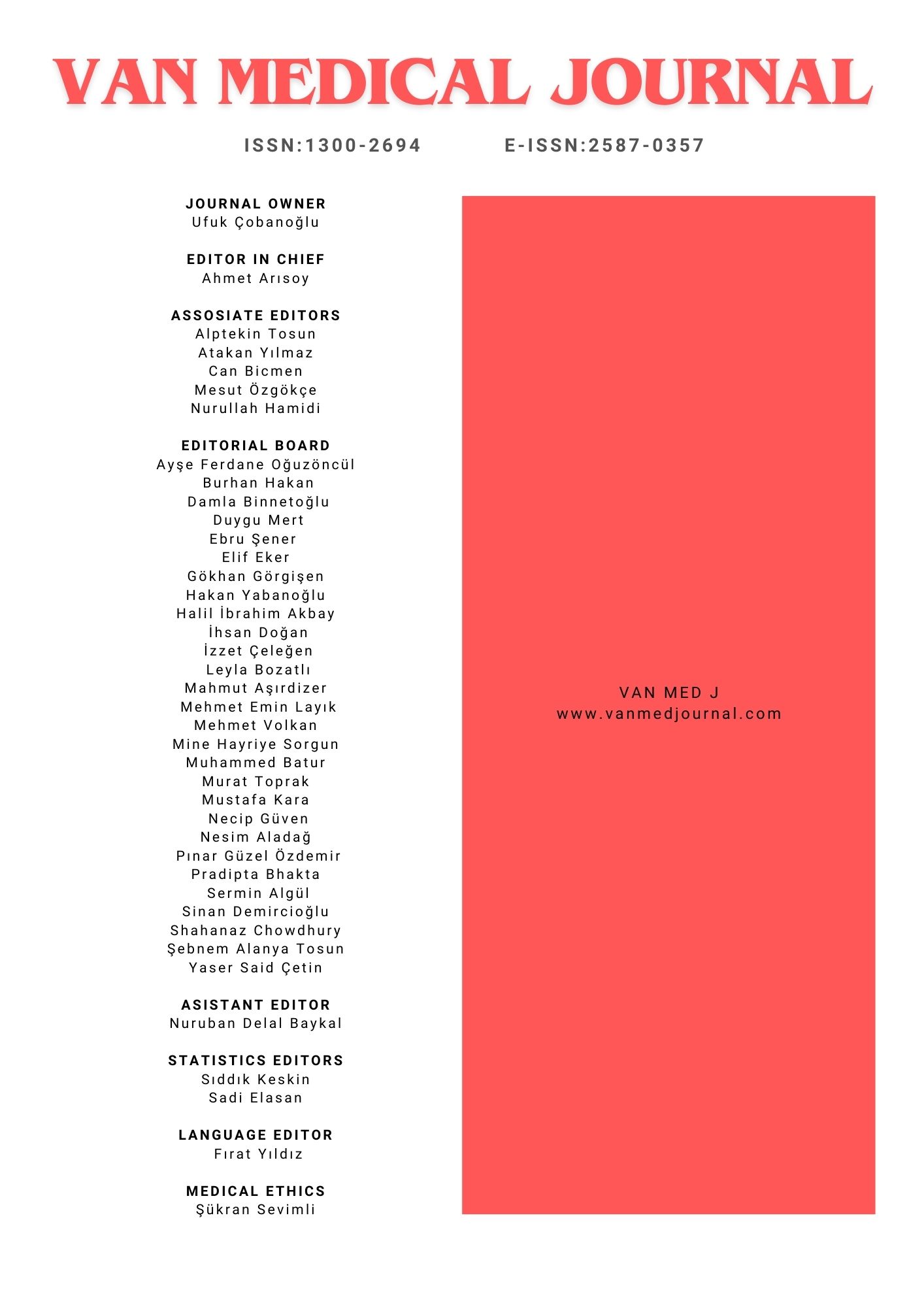Should antegrade pyelography be taken after percutaneous nephrolithotomy (pcnl)?
Kerem Taken1, Necip Pirinççi2, İlhan Geçit3, Serhat Tanık4, Recep Eryılmaz3, Mustafa Güneş31Van Bölge Eğitim ve Araştırma Hastanesi, Üroloji Kliniği, Van.2Yüzüncü Yıl Üniversitesi, Tıp Fakültesi, Üroloji Anabilim Dalı, Van.
3Yüzüncü Yıl Üniversitesi, Tıp Fakültesi, Üroloji Anabilim Dalı, Van.
4Van Bölge Eğitim ve Araştırma Hastanesi, Üroloji Kliniği, Van.
Objective: To avoid the unnecessary antegrade pyelography after percutaneous nephrolithotomy (PCNL). Material-Method: Between July 2010-August 2011, 85 patients who were performed PCNL were evaluated. In patients; percutaneous way was created by applying the dilation of 30F over a guide wire with Amplatz dilators. The process of crushing stone was carried out by using 26F rigid nephroscope (Wolf, Germany) and pneumatic lithotripter (Vibrolith-Elmed, Turkey). Open-ended 5fr or 6 fr ureteral catheter was placed into the ureter. Urinary tract radiography (DUSG) was taken in the 1st post-operative day and the ureteral catheters were removed. Nephrostomy was clamped and the follow-up of residue was done. Nephrostomy was taken if the residue were <50cc after 2-4 hours. Ureteral Double J (DJ) stent was applied to the patients who had urine from their nephrostomy tract after the removal of the nephrostomy catheter. Results: 68 of the patients were male and 17 of them were female. The mean age was 40.1 ± 12.15 (13-70) years. 74% of the stones (n: 64) was in the group of simple renal stone, but 26% of them (n = 21) was in the complex stone group. The mean stone burden was calculated as 320 mm ². We observed that 70% of our cases were entirely purified from the stone, there were clinically the pieces of insignificant stone at 23% of them, and it was resulted in failure at 7% of them. The average removal duration of the nephrostomy tube was 2.7 (1-5) days, but the average duration of hospital stay was 3.2 (2-6) days. There was no need to take the antegrade pyelography for none of the patients. Wetting from the tract went on in 7 patients for more than 24 hours after the withdrawal of the nephrostomy tube. It lasted for 2 days in 3 patients, 4 days in 2 patients, 8 days in 1 patient and 12 days in 1 patient. Double-J (DJ) catheter was placed to all of these patients. DJ stent was performed due to the detection of the stone fragments considered to be obstructive in DUSG taken in the available state of the ureteral catheter in the 1st day of post-surgery in 2 patients. Conclusions: We can avoid from unnecessary antegrade pyelographies by doing the residual follow-up after the percutaneous nephrolithotomy. Thus, we have prevented the intake of unnecessary radiation and the use of the contrast material.
Keywords: Antegrade pyelography, percutaneous nephrolithotomy, residue, stone.Perkutan Nefrolitotomi (pcnl) Sonrası Antegrad Pyelografi Çekilmeli mi?
Kerem Taken1, Necip Pirinççi2, İlhan Geçit3, Serhat Tanık4, Recep Eryılmaz3, Mustafa Güneş31Van Bölge Eğitim ve Araştırma Hastanesi, Üroloji Kliniği, Van2Yüzüncü Yıl Üniversitesi Tıp Fakültesi Üroloji Anabilim Dalı, Van
3Yüzüncü Yıl Üniversitesi, Tıp Fakültesi, Üroloji Anabilim Dalı, Van
4Van Bölge Eğitim ve Araştırma Hastanesi, Üroloji Kliniği, Van.
Amaç: Perkütan nefrolitotomi(pcnl) sonrasında gereksiz antegrade pyelografiden kaçınmak. Gereç-Yöntem: Temmuz 2010-Ağustos 2011 tarihleri arasında PCNL uygulanmış 85 hasta değerlendirildi. Hastalarda; amplatz dilatörler ile kılavuz tel üzerinden 30F dilatasyon uygulanarak perkütan yol oluşturuldu. Taş kırma işlemi 26F rijid nefroskop (Wolf, Almanya) ve pnömotik litotriptör (Vibrolith-Elmed, Türkiye) kullanılarak gerçekleştirildi. Üretere açık uçlu 5fr veya 6 fr üreter kateteri yerleştirildi. Post operatif 1.gün üriner sistem grafisi (DÜSG) çekildi ve üreter kateterleri alındı. Nefrostomi klemplenip rezidü takibi yapıldı. 2-4 saat sonrası rezidü<50cc ise nefrostomi çekildi. Nefrostomi kateteri alındıktan sonra nefrostomi traktından idrar gelen hastalara üreteral Double J (DJ) stent uygulandı. Bulgular: Hastaların 68’i erkek, 17’si bayandı. Yaş ortalaması 40.1 ± 12.15 (13-70) yıldı. Taşların %74’ü (n:64) basit böbrek taşı, %26’sı (n:21) kompleks taş grubundaydı. Ortalama taş yükü 320 mm² olarak hesaplandı. Olgularımızın % 70’inin tamamen taştan arındığı, %23’ünde klinik önemsiz artık taş parçaları olduğu, ve %7’sinde ise başarısızlıkla sonuçlandığı gözlemledik. Nefrostomi tüpünün ortalama çekilme süresi 2.7 (1-5) gün, ortalama hastanede kalma süresi ise 3.2 (2-6) gündü. Hiçbir hastaya antegrade pyelografi çekilmesine gerek kalmadı. Nefrostomi tüpü çekilmesi sonrası 7 hastada 24 saatten fazla trakttan ıslatma devam etti. 3 hastada 2 gün, 2 hastada 4 gün, 1 hastada 8 gün, 1 hastada ise 12 gün sürdü. Bu hastaların hepsine double-J (DJ) kateter konuldu. 2 hastada ise post op 1.gün de üreter kateteri mevcut durumunda çekilen DÜSG’de tıkayıcı olduğu düşünülen taş fragmanları saptanması üzerine DJ stent uygulandı. Sonuç: Perkütan nefrolitotomi sonrasında rezidü takibi yapılarak gereksiz antegrade pyelografilerden kaçınabiliriz. Böylece gereksiz radyasyon alımını ve kontrast madde kullanımını önlemiş oluruz.
Anahtar Kelimeler: Antegrade pyelografi, perkütan nefrolitotomi, rezidü, taş.Manuscript Language: Turkish

